|
Fantasy Football Strategy, Advice, and Commentary |
|

 By: Doug Orth — April 29, 2014 @ 11:56 pm By: Doug Orth — April 29, 2014 @ 11:56 pm
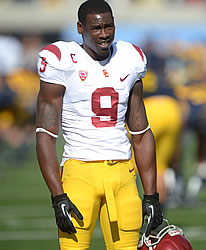 Lee plays bigger than his size. As we countdown to the NFL Draft starting on May 8, I will spend anywhere from 4-8 hours to break down the strengths and weaknesses of at least the top 20 or so offensive skill-position prospects available in this draft.
Vitals
College: USC
Height/Weight: 6’0”/192
Hands: 9 3/8”
Important NFL Combine Numbers
40-Yard Dash: 4.52
Vertical Jump: 38”
Broad Jump: 10’ 7”
20-Yard Shuttle: 4.01
3-Cone: N/A
Background (College Stats)
No matter what limitations he may have on the field, Lee has probably already overcome more adversity to this point in his life than he is likely to see during his pro career. The mere fact that he has been successful in spite of his upbringing and surroundings is a testament to his will and character, something that will likely not go unnoticed on draft day. Let’s provide a little background on Lee before moving on to his college career: both of his parents are deaf, his father was not regularly involved in his life and he moved frequently between his parents and grandparents before he and his sister were placed in foster care after he finished sixth grade. Both of his older brothers were involved in gangs – one died in a gang-related shooting while the other was imprisoned for attempted murder – and Marqise wanted to join them in the same gang, but his brothers did right by him and prevented him from doing so. Fortunately, Lee befriended a kid from a private high school by the name of Steven Hester Jr. after he joined the high school basketball team following his freshman year and eventually moved in with the Hester family in 2008. Lee finished as the No. 36 overall player in Rivals’ top 100 players in the 2011 recruiting class. The Pac-12’s Freshman Offensive Co-Player of the Year (along with Oregon’s DeAnthony Thomas) in 2011 took the conference by storm as a rookie (73-1143-11), combining with Robert Woods to accumulate the most receptions (184) and yards (2,435) by a receiving duo in school history – before they broke the record again the following season. With Woods drawing a lot of attention from opposing defenses after an 111-catch, 15-score campaign, Lee took his game to another level in 2012 with 118 receptions for 1,721 yards and 14 touchdowns while doubling as the Trojans’ starting kickoff returner – numbers that made the eventual All-American the clear-cut choice to receive the Fred Biletnikoff Award. Woods and QB Matt Barkley left for the NFL and, combined with an early knee injury, Lee turned in a disappointing season in 2013, recording career lows in catches (57), yards (791) and TDs (four).
NFL Player Comp(s): Antonio Brown
Strengths
- Vision and elusiveness make him one of the best run-after-catch receivers in this class.
- Smooth and explosive in and out of his cuts, knows how to set up defensive backs and understands how to manipulate man or zone coverage.
- Dynamic downfield receiver with the ability to “gear up” and run under the deep ball; plays bigger than his size.
- Makes the catch with his hands more often than not, quickly transitions from runner to receiver and does a nice job of working the sideline.
- Already proven he is physically tough and can handle adversity; willing to work the middle of the field and can contribute immediately in the return game.
- Tenacious downfield blocker, particularly for a receiver of his size.
Weaknesses
- Too many focus drops and double-catches for a player with so many spectacular catches on his resume (12.3 drop percentage in 2013, nearly three times higher than Sammy Watkins or Mike Evans).
- Relies a bit too much on his athleticism and can freelance his routes on occasion; will give up ground a bit too often in search for a bigger play.
- Average size may hinder his ability to “high-point” balls as effectively as he did in college or get away with an occasionally sloppy route.
- Needs to add strength – especially in his lower body – in order to break more tackles, get off the jam regularly and maintain blocks.
- Durability is a slight question mark.
- Tends to let the ball get away from his body in traffic.
Bottom Line
Unlike many of the bigger (and mostly disappointing) receivers to come out of USC in recent years, Lee is a smaller and more explosive dynamo that should be able to secure a No. 2 receiver job in the NFL in short order with the potential to be a lower-end top receiver at some point in his career if he is able to shore up some of his shortcomings. Injuries and a downgrade at quarterback played a large role in his rather large statistical drop-off from 2012 to 2013, but it is easy to forget that Woods occupied a lot of defensive attention during Lee’ s Biletnikoff Award-winning campaign. Much like college quarterbacks that lack accuracy, it is hard for a college receiver to develop “better hands” as they move to the pros, so interested NFL teams must figure out if his high drop percentage comes from a lack of consistent focus or hand placement (or both) and decide if it is a problem they can correct. Because he lacks the mismatch potential of Watkins and Evans as well as the kind of explosion that players like Odell Beckham Jr. and Brandin Cooks possess (and the natural hands of all four), Lee slots somewhere between the fifth-best and eighth-best receiver in this class. However, that assessment should hardly be considered a knock because it is entirely possible that each of the aforementioned players will be No. 1 receivers within a year or two in the league. Lee is obviously a tough customer that has the heart and run-after-catch ability to be a productive player for a long time in the NFL if he can lower last season’s drop rate and add some more muscle in order to better protect himself.
 By: Doug Orth — April 27, 2014 @ 11:26 pm By: Doug Orth — April 27, 2014 @ 11:26 pm
As we begin the countdown to the NFL Draft starting on May 8, I will spend anywhere from 4-8 hours to break down the strengths and weaknesses of at least the top 20 or so offensive skill-position prospects available in this draft.
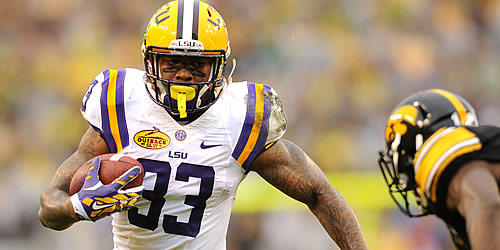 Is Jeremy Hill the “second coming” of Steven Jackson? Vitals
College: LSU
Height/Weight: 6’1”/233
Hands: 10 1/4”
Important NFL Combine Numbers
40-Yard Dash: 4.66
Vertical Jump: 29”
Broad Jump: 9’ 5”
20-Yard Shuttle: N/A
3-Cone: N/A
Background (College Stats)
Hill was considered a four-star athlete and 21st-best running back in the country by Rivals.com in 2011 recruiting class, but his narrative really began as a senior in high school off the field. Without getting into the sordid details of the incident (summarized nicely by CBS Sportsline national columnist Gregg Doyel), Hill eventually pled guilty to a misdemeanor charge of carnal knowledge of a juvenile. LSU coach Les Miles honored his scholarship offer anyway and Hill sat out the 2011 fall semester as a result. The Baton Rouge native stayed out of trouble in 2012 and became the first freshman to lead the Tigers in rushing (755 yards) since Justin Vincent in 2003. Unfortunately, a then-still-underage Hill ended up in the news again in August 2013 due to a simple battery charge for punching a man in the head outside of a bar. That incident ultimately led to a two-year probation (since lifted) and Miles made the curious decision to leave it up to Hill’s teammates as to whether or not they would allow the Tigers’ top back on the team before the start of the season. Once his teammates “unanimously” – in the words of Miles – agreed to let Hill return, Miles handed Hill what amounted to a 1 ½-game suspension at the start of the 2013 campaign. The third-year sophomore started to take control of the LSU backfield the week after his return and went on to post some gaudy numbers, running for 1,401 yards (second-most in school history), a 6.9 yard-per-carry average (an SEC record) and 16 touchdowns. The second-team all-conference selection put an exclamation point on his final college season in the Tigers’ 21-14 Outback Bowl victory over Iowa, turning 28 carries into 216 yards and two touchdowns.
NFL Player Comp(s): A rich man’s LeGarrette Blount
Strengths
- Hard-charging between-the-tackles back that breaks a lot of tackles and keeps his legs driving through contact.
- Downhill runner who attacks the hole and can make a defender miss with a spin move or by leaping over them (will not string back-to-back moves together, however).
- Solidly-built back with quicker feet and better long speed than most backs his size.
- Wasn’t used much as a receiver or a pass blocker and needs to develop in both areas, but is hardly a liability at either; showed the ability to be a solid check-down option when needed.
- Ball security (committed only one fumble in college, but did not lose it).
- Age (21) and career workload (371 touches).
Weaknesses
- Character (arrested twice while in college).
- Lacks elusiveness and speed is of the build-up variety; will likely require a complementary “space” back as he struggles when forced to go east-west.
- Runs higher than he should on occasion and doesn’t always “keep his feet”, negating some of the size/strength he typically enjoys on linebackers and/or defensive backs.
- Runs up the heels of his blockers too often.
- Could be playing with fire in terms of ball control; has huge hands, but holds the ball with just one – often even when fighting for extra yards and in traffic.
Bottom Line
Hill is easily a better prospect than Blount, but it has been suggested the former might be the “second coming” of Steven Jackson if he keeps his nose clean and fully commits to being the best he can be. Suffice it to say that his while Hill’s potential upside exceeds Blount’s, he is nowhere close to where Jackson was coming out of Oregon State. (At his best, Hill’s NFL career could mimic that of Cedric Benson’s.) The second-team All-SEC selection is a better athlete and has more lateral agility and speed than the Pittsburgh Steelers’ new backup running back, although he, like Blount, is highly athletic for a big back and a runner that should be enjoy a fairly long career as an early-down option. Where Hill differs from his NFL comp is that he has already shown the ability to catch the ball in limited opportunities and is a better short-yardage/goal-line option. With that said, it is hard to see Hill prospering in the NFL in anything outside of a downhill, power-based running scheme because he is well below-average moving east-west and doesn’t possess the kind of above-average burst a back usually needs to get through the hole consistently on outside zone runs. Although there is plenty to like about Hill’s on-field exploits, his power isn’t nearly enough to push him to the top of the draft class at his position. He is firmly behind Carlos Hyde and Bishop Sankey (considered by many the top two backs available in the 2014 NFL Draft) and fits somewhere in the second tier of running backs available in May, especially after considering his off-field history.
//
 By: Doug Orth — @ 4:07 pm By: Doug Orth — @ 4:07 pm
As we begin the countdown to the NFL Draft starting on May 8, I will spend anywhere from 4-8 hours to break down the strengths and weaknesses of at least the top 20 or so offensive skill-position prospects available in this draft.
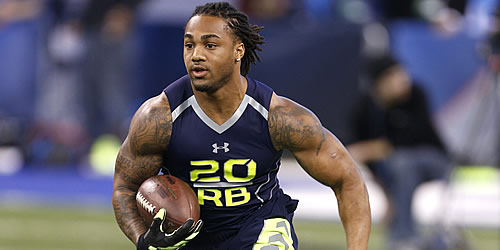 Mason needs to improving his blocking ability if he wants to be successful in the NFL. Vitals
College: Auburn
Height/Weight: 5’8”/207
Hands: 9”
Important NFL Combine Numbers
40-Yard Dash: 4.50
Vertical Jump: 38 1/2”
Broad Jump: 10’ 6”
20-Yard Shuttle: 4.15
3-Cone: N/A
Background (College Stats)
Mason rushed for 1,643 yards and 24 touchdowns as a high-school senior in 2010 and was rated as the No. 14 running back in the nation that year by Rivals.com. Although he only recorded one carry for two yards in his first collegiate game against Utah State, the Palm Beach (Fla.) native hinted at the success that awaited him when he returned a kick 97 yards for a touchdown in the same contest. Mason began to work his way into the rotation a bit more by the time the Tigers qualified for the Chick-fil-A Bowl at the end of his freshman season and really began to emerge as the focal point of the running game midway through Auburn’s disastrous 2012 season; he also kept the school’s four-year streak of having at least one 1,000-yard rusher going on his last carry of the season in the Tigers’ 49-0 loss to Alabama in the Iron Bowl; he finished with 1,002 yards as a sophomore and started his final college season on a similar track before new coach Gus Malzahn really got his high-speed, run-focused spread attack on track around midseason this past year. The first non-quarterback to lead Auburn in total offense for a season since Bo Jackson in 1985, Mason averaged an unthinkable 31.3 carries over the final six games of his college career and continued to produce at the same level (on a yard-per-carry basis) that he was over the first half of the season. The first-team all-conference selection cemented his status as a Heisman Trophy finalist in the defense-optional SEC Championship when he posted 46 carries for 304 yards and four touchdowns, setting five title-game records in the process. He closed his college career with six straight 100-yard games and solidified his status as a top running back prospect almost a month later when he gouged Florida State for 195 more yards and a score on the ground on 34 attempts in the BCS National Championship.
NFL Player Comp(s): Marion Barber III
Strengths
- Compactly-built runner with good balance (most of the time); delivers the blow much more often than he receives it and runs much bigger than he is.
- Powerful lower body allows him to keep his legs moving and drives through contact; can smell the end zone (but is not a pile-mover per se).
- Decisive, yet patient, one-cut back with quick feet and the ability to stop and start quickly.
- Did most of his damage inside the tackles in college, but has enough burst to beat most defenders to the edge.
- Capable of handling heavy workloads (refer to the 2013 SEC Championship against Missouri and the 317 carries he accumulated in 2013).
- Showed incredible stamina to serve as main back in Auburn’s high-speed offensive attack as well the team’s leading kick returner.
- Adds versatility as a dynamic kick returner.
Weaknesses
- Ball security (career fumble rate of 1.6 percent) needs to be addressed.
- Displays good, but not great, breakaway speed.
- A virtual unknown in the passing game (19 career receptions).
- Unlikely to get much bigger as frame appears to be close to maxed out; can he continue to play as physical as he does at his current size and does he need to be part of a committee?
- Did not attempt to make many tacklers miss early in his career, although he made significant strides as 2013 progressed.
- Did not appear to be all interested in blocking at times; does not use cut-blocks all that often and runs the risk of being overmatched if he doesn’t add it to his arsenal.
Bottom Line
The highly-respected personnel guru Gil Brandt went so far as to say Mason is comparable to Tony Dorsett, at least from a quickness standpoint. There is no doubt the SEC’s leading rusher in 2013 has a nice blend of quickness and power, but it would be a mistake to suggest he is like Dorsett in many other ways. There are too many major questions at this point with Mason to consider him the top prospect at his position, with the most notable drawback being that he appears to be a long ways away from being a well-rounded back. Although Auburn did not attempt many passes in 2013, Mason truly appeared disinterested in blocking. Needless to say, there are not a lot of running backs in the NFL that reach feature-back status unless they become at least average blockers – and Mason is a long ways away from that. Furthermore, he’s got the size of a traditional scatback and the game of an early-down pounder, which makes him something of a tweener that may have very well been a product of Malzahn’s up-tempo spread offense. With that said, it is impossible to ignore how he finished his college career or the desire with which he runs. The NFL will always have a place for backs like Mason that can run through arm tackles and make good decisions as a ball-carrier. His best fit is likely with an offense that runs a lot of zone-blocking and/or spread schemes; the former because he is decisive, one-cut runner with good vision and power and the latter because it increases the odds he’ll win the physical confrontation with a safety in the hole much more often than he will with a linebacker. At this point, it seems unlikely he can become a “foundation back” anytime soon – at least until he shows a lot more ability in every aspect of the passing game.
 By: Doug Orth — April 25, 2014 @ 2:01 pm By: Doug Orth — April 25, 2014 @ 2:01 pm
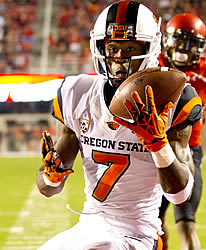 Despite his size, Brandin Cooks could be a late first-round pick. As we begin the countdown to the NFL Draft starting on May 8, I will spend anywhere from 4-8 hours to break down the strengths and weaknesses of at least the top 20 or so offensive skill-position prospects available in this draft.
Vitals
College: Oregon State
Height/Weight: 5’10”/189
Hands: 9 1/2”
Important NFL Combine Numbers
40-Yard Dash: 4.33
Vertical Jump: 36”
Broad Jump: 10’
20-Yard Shuttle: 3.81
3-Cone: 6.76
Background (College Stats)
A three-sport athlete at Lincoln High School in Stockton (Calif.) who earned the nickname of “Sonic Boom” for his exploits as a sprinter, Cooks broke the hearts of most of the Pac-12 Conference when he committed to the Beavers. He made an immediate impact as a freshman, finishing third on the team behind Markus Wheaton and James Rodgers in receptions (31) and receiving yards (391) while tying for the team lead in receiving touchdowns (three). Cooks essentially stepped into Rodgers’ old role as the second option in the Oregon State passing attack as a sophomore, combining with Wheaton to form one of the best receiving duos in the country while also ushering the biggest single-season turnaround in school history (from 3-9 in 2011 to 9-4 in 2012). Although Cooks was obviously a key part of the offense (67 catches, 1,151 yards and five touchdowns), he didn’t appear all that likely to dominate college football in 2013 as was limited to three catches or fewer in three of his final four games as a sophomore. However, once Wheaton left for the NFL and Oregon State settled on Sean Mannion as its quarterback, the Pac-12 became Cooks’ little playground and opponents were nearly powerless against the mighty mite. In his final season, the consensus All-American caught at least six passes in every game and was held under 100 yards receiving only four times (with his low point being 88 yards against USC). Unsurprisingly, Cooks set the Pac-12 record for receptions in a season (128) and led the FBS with 1,730 yards en route to becoming the second Beaver to claim the Biletnikoff Award.
NFL Player Comp(s): A less physical Steve Smith
Strengths
- As explosive and elusive as any receiver in this class and perhaps the best at transitioning out of his breaks, which only serves to accentuate his ability as a fine route runner.
- Stop/start ability and vision make him a terror in the open field; possesses the speed to take away a defensive back’s angle and has proven he can beat double teams.
- Shows no fear running over the middle and has the ability to turn any run or catch into a big play.
- Wins more one-on-one battles downfield than many bigger receivers do thanks in part to impeccable timing, solid ball skills and stronger/bigger hands than most wideouts his size.
- Always seems to know where he is on the field and works the sideline beautifully.
- A tough player that seems to get “it” with no history of durability or off-field issues.
Weaknesses
- Among the smallest receivers available and does not have the frame to add much more muscle/weight.
- Struggles with the few physical defenders that can stay in front of him at the line of scrimmage.
- While unafraid to work the middle of the field or in traffic, he is unlikely to generate many yards after contact.
- Does not project well on a run-heavy team and may never have enough size to do more than get in the way of a defender as a blocker.
Bottom Line
With Wheaton in the NFL and no running game to speak of in 2013, Oregon State had to rely on Cooks and the Beavers’ opponents knew they had to stop him. Suffice it to say that opposing defenses usually failed miserably. It’s hard to recall the last time a major-college receiver – especially one with Cooks’ size – attracted so much attention from opposing defenses and still thrived. (Look no further than Oregon State’s “Civil War” game with Oregon to see the number of times Cooks drew two or even three defenders, even on play-action passes.) The NFL is littered with receivers that were dogged about their lack of size coming out of college, only to prove their talent and desire to compete were much greater than any height/weight concerns that personnel executives had prior to drafting them. Few of the undersized receivers have the breathtaking ability and overall game that Cooks does, however. It’s entirely possible that Cooks will get drafted late in the first round by a team that has the luxury of starting him out as purely a slot receiver (which would alleviate any concerns about his ability to defeat physical coverage), but there is little doubt he will have the ability to lift the top off the defense right away. Cooks is about 2-3 inches and 10-15 pounds shy of pushing Sammy Watkins for top rookie prospect honors, but a savvy offensive coordinator shouldn’t have much problem getting instant production out of him. Much like Watkins, there are very few weaknesses in his game. Cooks may lack the size to be a consistent red-zone weapon (at least initially), but he is so much more than a one-trick pony, meaning his ceiling is higher than that of a Mike Wallace or DeSean Jackson.
 By: Doug Orth — April 23, 2014 @ 11:29 am By: Doug Orth — April 23, 2014 @ 11:29 am
As we begin the countdown to the NFL Draft starting on May 8, I will spend anywhere from 4-8 hours to break down the strengths and weaknesses of at least the top 20 or so offensive skill-position prospects available in this draft.
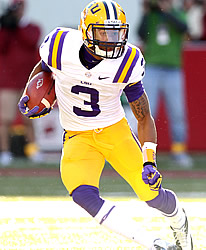 Odell Beckham Jr.’s floor as a top-shelf No.2 WR makes him a first round prospect. Vitals
College: LSU
Height/Weight: 5’11”/198
Hands: 10”
Important NFL Combine Numbers
40-Yard Dash: 4.43
Vertical Jump: 38 1/2”
Broad Jump: 10’ 2”
20-Yard Shuttle: 3.94
3-Cone: 6.69
Background (College Stats)
A four-star recruit by Scout.com and Rivals.com as well as the son of an All-American sprinter (Heather Van Norman) and a former starting running back for LSU from 1989-92 (Odell Beckham Sr.), Beckham Jr. followed his parents’ footsteps when he stayed in Louisiana to play for the Tigers. He garnered freshman All-SEC honors in 2011 and added return duties to his resume on more of a full-time basis the following year. Beckham continued his improvement in his final season at Baton Rouge, earning a first-team All-SEC selection from the coaches and winning the Paul Hornung Award as the most versatile player in FBS after shattering the school’s single-season record for all-purpose yardage as a junior (2,222) previously held by Domanick Davis (2,120) in 2002. Beckham’s most dominating performance may have come against UAB in 2013, when he posted a 5-136-3 line against the Blazers while returning a punt 60 yards and a missed field goal 100 yards for a fourth touchdown. In the end, it all added up to 331 all-purpose yards – one of six times in 2013 he gained at least 217 in a game.
NFL Player Comp(s): Randall Cobb
Strengths
- Great burst and reaches top speed quickly; fluid out of his breaks and perhaps the “smoothest” receiver in this class.
- Will work over the middle and is willing to take punishment in order to make the big play.
- Can make the difficult catch look easy at times.
- Has huge/strong/quick hands; plucks ball out of the air on high-point throws and rarely allows the ball to get into his body.
- Superb body control; made significant improvement in ball skills during 2013.
- Dynamic returner and all-purpose yardage threat.
- Transformed himself from great athlete to great college player; no questions regarding durability and off-field behavior.
Weaknesses
- Has no issues with gaining separation, but got caught from behind a bit too much for a player with his timed speed (reflected by the high number of big plays he created versus the relative lack of touchdowns).
- Still a work in progress in terms of catching the ball consistently in traffic, although he made major strides in this area as well in 2013.
- Is more dash than smash; could stand to add more muscle.
- While he is obviously a very explosive athlete, less-than-ideal height may make high-point throws a bit more risky in the pros.
- Could show better effort on a more consistent basis as a blocker.
Bottom Line
Beckham made his mark primarily as a deep threat in his final season at LSU, but his willingness to work the middle of the field and ability to create yards after the catch in the short and intermediate passing game is probably how Beckham will leave his impression at the NFL level. Absent of being a true speed demon, one way a young receiver can distinguish himself early on is to be a “smooth” route runner and contribute on special teams; check and check. The only disturbing part of the New Orleans native’s college tape was the number of times he was able to break loose for the big play because of his elusiveness, only to get caught from behind. With that said, Beckham has very little downside as a prospect because he should make an instant impact as a returner while he continues to hone his craft at the next level. Even though his final college receiving totals don’t exactly jump off the page, talent evaluators understand that LSU has more of a balanced, pro-style offensive attack that won’t necessarily inflate a player’s end-of-season numbers. Those same evaluators love to see a prospect that improves by leaps and bounds each season and takes to pro-level coaching when he has access to it and Beckham did exactly that. (Longtime NFL play-caller Cam Cameron became the Tigers’ OC prior to the start of last season.) Whereas I have a few reservations about a receiver like USC’s Marqise Lee unless he finds his way into the right scheme, Beckham is a player whose floor should be as a top-level No. 2 receiver in the NFL – almost regardless of the offensive system – for the next decade. As for his upside, he could emerge as the top receiver in this draft class.
 By: Doug Orth — April 21, 2014 @ 10:34 am By: Doug Orth — April 21, 2014 @ 10:34 am
As we begin the countdown to the NFL Draft starting on May 8, I will spend anywhere from 4-8 hours to break down the strengths and weaknesses of at least the top 20 or so offensive skill-position prospects available in this draft.
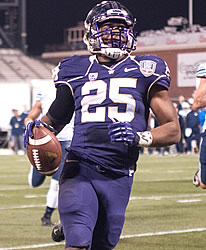 Durability is just one of many assets in Bishop Sankey’s game. Vitals
College: Washington
Height/Weight: 5’9”/209
Hands: 10”
Important NFL Combine Numbers
40-Yard Dash: 4.49
Vertical Jump: 35 1/2”
Broad Jump: 10′ 6″
20-Yard Shuttle: 4.00
3-Cone: 6.75
Background (College Stats)
Rated the 17th-best running back in the country by Scout.com after finishing his high-school career at Gonzaga Prep in Spokane (Wash.), Sankey saw just 28 carries as a freshman as Chris Polk wrapped up his brilliant career with the Huskies and was expected to split time in 2012 with Jesse Callier before Callier succumbed to a knee injury in the season opener that year. Suffice it to say that Sankey never gave the Huskies’ coaching staff a reason to consider a timeshare thereafter as he became the centerpiece of the offense and finished his sophomore season with 1,439 rushing yards (the third-highest total in school history at the time) and 16 touchdowns. Perhaps his most impressive achievement in that campaign came when he earned MVP honors in the MAACO Bowl despite the fact his team lost 28-26 to Boise State. (It marked the first time in the bowl game’s 21-year history that a player from the losing team was named MVP.) In that contest, Sankey rushed for a bowl-record 205 yards and added 74 more as a receiver. As good as Sankey was near the end of 2012, he was even better in his final college season, running for over 200 yards on three occasions in the Huskies’ up-tempo attack. He set the school’s single-season record holder in rushing yards (1,870 – the third-highest total in the country in 2013 and 175 more than Washington legend Corey Dillon ran for in 1996) and posted 37 career scores on the ground, three more than former Husky standout Napoleon Kaufman (1991-94).
NFL Player Comp(s): Doug Martin
Strengths
- Possesses perhaps the best vision of any runner in this class; patient runner who sets up his blocks well and routinely makes the first defender miss.
- An imposing combination of quick feet and underrated power; grinds out more yards after contact than most backs his size.
- Impressive inside runner; almost always seems to make the right choice in regards to when he needs to power through the hole or when enough time to juke a defender.
- Incredible lateral agility and one of the rare backs that can make a two-gap jump cut (like LeSean McCoy) while maintaining his balance and still beat the defender to the edge.
- Reliable blocker and pass-catcher out of the backfield (67 career receptions), likely has the ability to be flex out as a receiver, although he was not asked to do much more than catch dump-offs and screens in college.
- Named team captain in 2013 and has solid reputation as a “gym rat”; did not miss a game in his college career.
Weaknesses
- Play speed appears to be a bit slower than timed (track) speed; defenders caught him a number of times after he advanced past the second level of the defense.
- Ball security was an issue throughout his career despite big hands (fumbled nine times on 718 career touches), although he improved in this area in 2013 (three fumbles on 355 touches).
- Tends to rely too heavily on cutting defenders as a pass blocker; needs to be able to stay on his feet and anchor from time to time and could stand to be more aware in picking up his blitz assignments.
- Saw 653 touches over his final two seasons, proving he could be a true feature back while also running up his odometer.
- Is more than capable of converting short-yardage/goal-line opportunities, but is unlikely to be a true “hammer” in those situations.
Bottom Line
Sometimes, a running back comes along that almost seems to paint a masterpiece when he runs. Sankey has an uncanny knack of knowing exactly when to make his first cut and the rare ability to make potential tacklers come up empty in small areas with his ability to pick and slide between tackles. Whether he makes a decision to lower his pads or juke the defender, his call in those split-second situations is rarely ever wrong and has probably contributed to his durability since he usually avoids the big hit. Sankey rightfully draws comparisons to the Cincinnati Bengals’ Giovani Bernard, but it should be noted the former is more powerful and runs with more conviction between the tackles while the latter is more electric and a bigger-play back. There have been reports/accounts of respected draft experts suggesting that Sankey goes down on first contact a lot, so while it may have true some of the time in his career, I watched eight of his 2013 games and saw a powerful runner who often powered through the initial tackle. The team that drafts Sankey may be wise to keep his touches down in his rookie year (at least early on, in order for him to preserve him for later in the season and into the future), but there’s little doubt he is a feature-back talent so long as he continues to shore up the few weaknesses in his game. There is no doubt in my mind that if Sankey finds the right team, he has the capacity to be every bit as good of a pro, if not better, than Martin or Bernard.
 By: Doug Orth — April 17, 2014 @ 6:27 pm By: Doug Orth — April 17, 2014 @ 6:27 pm
As we begin the countdown to the NFL Draft starting on May 8, I will spend anywhere from 4-8 hours to break down the strengths and weaknesses of at least the top 20 or so offensive skill-position prospects available in this draft.
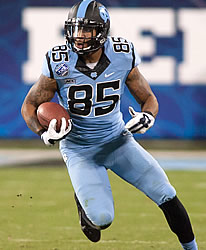 Ebron: The next great receiving threat at tight end? Vitals
College: North Carolina
Height/Weight: 6’4”/250
Hands: 10”
Important NFL Combine Numbers
40-Yard Dash: 4.60
Vertical Jump: 32”
Broad Jump: 10’
20-Yard Shuttle: N/A
3-Cone: N/A
Background (College Stats)
Ebron excelled at both tight end and defensive end at Ben L. Smith High School in Greensboro, N.C., and was rated as a three-star recruit from Rivals.com. He saw action in 10 games and flashed his big-play ability as a true freshman, averaging 20.7 yards on 10 catches in 2011. Ebron became a starter the following season and promptly smashed the Tar Heels’ single-season school records for a tight end in receptions (40) and receiving yards (625), numbers topped only by Vernon Davis and Heath Miller at the position in ACC history. The 2012 second-team All-ACC selection continued to terrorize defenses in his final college season, breaking Davis’ conference single-season record for receiving yards by a tight end (973) while also shattering his own school record for receptions (62). Ebron, who was named a Mackey Award finalist for his efforts, enjoyed his finest game in 2013 in a nationally-televised contest against Miami (Fla.) when he established new career highs with eight catches and 199 receiving yards. The highlight of his performance was a 71-yard touchdown reception that perhaps encapsulated his rare talent the best: Ebron took a pass on a short rollout from quarterback Marquise Williams around the Tar Heels 41, broke a pair of tackles and easily outraced the rest of the Hurricane defense down the sideline the final 59 yards for the score.
NFL Player Comp(s): Vernon Davis
Strengths
- Absolute matchup nightmare down the middle of the field; prototypical tight end size with the speed, burst and acceleration to take any pass the distance.
- Spent a significant time in the slot in 2013 and looks like a natural; should be an above-average “move” NFL tight end right away.
- Routinely shows an understanding as to how to maximize his physical talent as a receiver.
- Plants and accelerates out of a break just like a receiver.
- Often makes the difficult catch look easy, especially in the red zone.
- Does a good job of sitting down in zone coverage and is willing to take the punishment that comes along with it.
Weaknesses
- Dropped a few more catchable balls than he should have (11 percent drop percentage in 2013, highest of all the top prospects at his position); seems to be more reliable on throws away from his frame than on-target passes.
- Although he separated easily from defenders in college, he lacks polish as a route runner; telegraphs his breaks and allows himself to get redirected from time to time.
- Effort and technique as a blocker are inconsistent; has the potential to be dominant in this area with better attention to detail and more strength.
- Shows incredible desire to make the big catch in the red zone, but needs that same passion over the rest of the field.
- Is guilty of losing focus occasionally when he’s not the top option in the passing game.
Bottom Line
Stating the somewhat obvious, Ebron is a rare physical talent and perhaps the most physically-gifted tight end to come out of college in recent years. North Carolina used him a great deal out of the slot and in a variety of ways, including on the occasional jet sweep or tunnel screen. His current shortcomings aren’t all that different from those of most college prospects and should become less of an issue so long as he takes to professional coaching and embraces football as his full-time job. His strengths, however, are incredibly rare for a 6-4, 250-pound young man who can pull away from safeties, linebackers and most cornerbacks. Critics will point to the high drop percentage and, while it is a legitimate concern, there is more than enough tape to suggest his biggest problem is focus. Look no further than two of his most incredible one-handed catches in 2013 to understand why that may not be as big of an issue with him as it might be with another player. On a 19-yard touchdown catch against Georgia Tech, Ebron hauled in a pass that was probably 2-3 feet over his head with his left hand. On another poor throw weeks later against Miami (Fla.), he runs up the field and shows enough ability to turn his hips around despite running near full speed to reach around with his right hand on a pass thrown high and about 4-5 feet behind where it should have been placed. In short, he has natural hands. Although it is very likely he will be used primarily as a field-stretcher in his rookie year, it would be a mistake if a team decided to limit him to that role long-term. His floor should be what Davis has accomplished this far, because Ebron is less raw now than Davis was coming out of Maryland. Assuming he wants it bad enough, there is no reason why Ebron can’t make it to at least 3-5 Pro Bowls in his NFL career.
 By: Doug Orth — April 15, 2014 @ 10:25 am By: Doug Orth — April 15, 2014 @ 10:25 am
As we begin the countdown to the NFL Draft starting on May 8, I will spend anywhere from 4-8 hours to break down the strengths and weaknesses of at least the top 20 or so offensive skill-position prospects available in this draft.
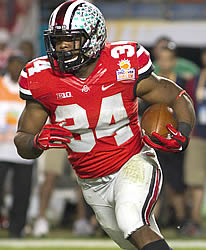 Hyde: A north-south runner that should be featured at the goaline. Vitals
College: Ohio State
Height/Weight: 6’0”/230
Hands: 9 1/2”
Important NFL Combine Numbers
40-Yard Dash: 4.66
Vertical Jump: 34 1/2”
Broad Jump: 9’ 6”
20-Yard Shuttle: N/A
3-Cone: N/A
Background (College Stats)
After growing up in Cincinnati and beginning his high school education in Ohio, Hyde moved to Naples, Fla. to complete his schooling. Rivals.com ranked him as a four-star player and the second-best fullback prospect in the country in 2008. Ohio State saw him as a viable big-back replacement for Chris “Beanie” Wells and convinced him of such, allowing the Buckeyes to beat out Florida, Miami (Fla.), Florida State and a host of other schools for his services. However, Hyde spent the 2009 fall semester at Fork Union Military Academy (Va.) in order to raise his ACT scores because he didn’t qualify academically right away. He finally landed in Columbus for good in January 2010 and played second-fiddle to Dan “Boom” Herron over his first two seasons before breaking out with 970 yards and 16 rushing touchdowns as a junior despite missing two games (and part of a third) with an ankle injury. Hyde found himself in hot water in July 2013 when Buckeyes coach Urban Meyer suspended him three games for “conduct not representative of this football program or this university” when he attempted to strike a woman in a bar. Although he avoided any criminal charges, Meyer stuck to his punishment and it appeared to light a fire under Hyde, who became the first Meyer-coached back to rush for at least 1,000 yards. The 2013 first-team All-Big Ten selection finished his final season with 1,521 yards rushing – good for the 13th-best mark in the country – and accomplished the feat by posting at least 111 yards in each of his last nine contests.
NFL Player Comp(s): Alfred Morris/Zac Stacy
Strengths
- North-and-south runner that typically powers through the first tackle and almost always gets at least 2-3 yards after contact; should be a top-level goal-line back right away.
- Is not strictly a straight-line bulldozer; light on his feet, shows good balance and can change direction better than expected for a player of his size.
- Ball security (career fumble percentage of 0.7); shows good fundamentals in terms of keeping the ball tight to his frame and covers it with two hands in traffic.
- Decisive runner that accelerates quickly, allowing him to pack even more of a punch when he makes contact with a defender.
- A rare college power back that was not overexposed (523 career carries in four years with no more than 208 in any season).
Weaknesses
- More of a between-the-tackles runner that lacks the speed to consistently break a big run, although he showed much more big-play ability in 2013 after dropping roughly 15 pounds from the previous season.
- Showed the ability to catch the ball out of the backfield when used in that fashion, but is little more than a safety-valve/check-down option at this point (34 career receptions, including just 16 in his final season).
- Not an upright runner, but tends to lower his shoulder a split-second too late – absorbing more punishment than he should – and relies a bit too much on bulk to power over defenders.
- Dealt with injuries, conditioning issues and off-field concerns in college (was the suspension enough to “wake him up” or will he constantly need outside motivation?).
- Has the build and desire to be a good blocker, but should dominate in that area more often than he does.
Bottom Line
Meyer hasn’t exactly lined up a who’s who of running backs in his 12 seasons as a college coach and generally spread the rushing load as a result, but it is still pretty telling that Hyde became the first one of his backs to surpass 1,000 yards in a season. Much like Eddie Lacy the year before he was drafted, Hyde was more of a big back without much suddenness in the year before he made himself available in the draft. Again, like Lacy, Hyde went from merely a big back to a powerful back capable of carrying the load in his final college season. Even as inflated as some of the yards-per-carry averages are in college football, Hyde’s 7.3 mark in 2013 is an incredibly high number for a 230-pound back – especially one in a BCS conference. Still, it is hard to overlook the fact that the third-team AP All-American was unable to put together a full season in any of his four years AND that he needed Meyer’s tough love to maximize his talent, but it isn’t overly difficult to understand why he is considered by some to be the best back in this draft. Finding agile big backs with a bit of explosion is a tough gig and Hyde is one of those few backs. As suggested above, he is a likely “foundation” back at the next level in the Morris and/or Stacy mold, capable of carrying his team’s running game so long as he maintains the same kind of work ethic that enabled him to hit the ground running following his suspension to begin the 2013 season. His draft stock will almost certainly get dinged a bit due to his character/injury history (and rightfully so), but the tools and talent are there for Hyde to be an above-average NFL running back if he wants it bad enough.
« Newer Posts — Older Posts »
| |
|
Powered by
WordPress |
|

|








